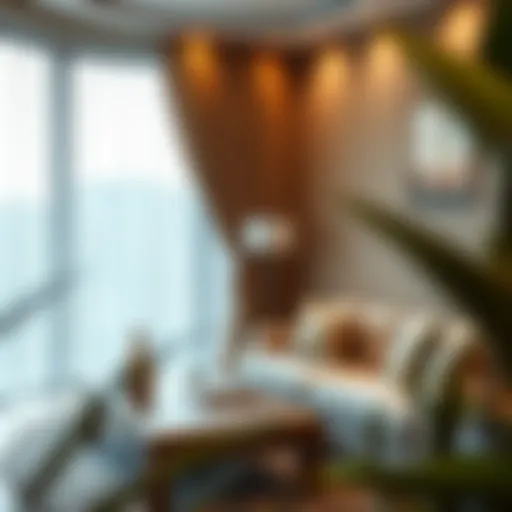Enhance Your Kitchen with Decorative Cabinet Feet
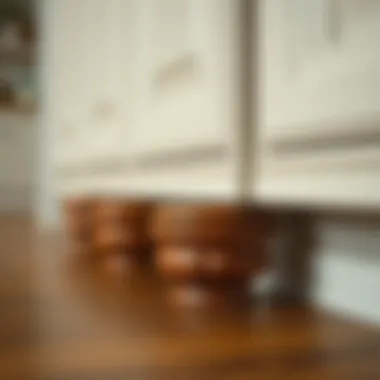
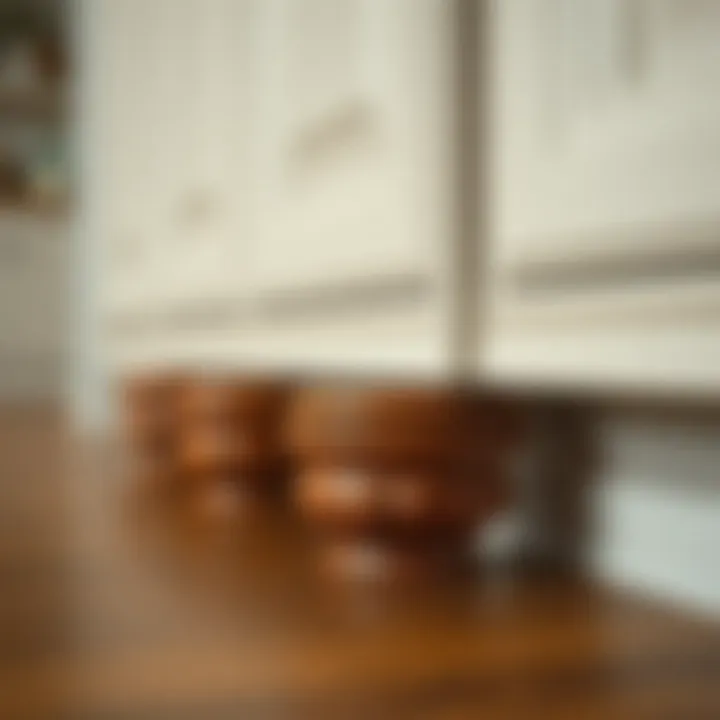
Intro
When it comes to kitchen design, many homeowners often focus on the big ticket items: flooring, cabinetry, countertops, and appliances. Yet, there’s a subtle detail lurking in the shadows that can dramatically alter the visual appeal of kitchen cabinets. Enter decorative feet. These often-overlooked elements not only add a touch of style, but they also serve functional purposes that can elevate the overall design of your kitchen.
In this guide, we will embark on an intricate exploration of decorative feet for kitchen cabinets. From understanding their role in enhancing aesthetics to navigating practical considerations for installation and maintenance, we’ll cover it all. Whether you’re a homeowner aiming to refresh your space, a designer looking for inspiration, or a DIY enthusiast eager to take on a new project, there’s something here for everyone. Let’s dive deeper into this world where wood, creativity, and utility intertwine.
Preamble to Decorative Feet
When it comes to kitchen design, every little detail plays a significant role, and decorative feet for cabinets are no exception. These components are more than just aesthetic embellishments; they serve a variety of functions that impact both the look and functionality of your kitchen. As we delve into the world of decorative feet, we aim to shed light on their importance in kitchen design, highlighting how they can redefine the atmosphere of your cooking space.
Defining Decorative Feet
Decorative feet are the structural elements that support cabinetry while adding style to the overall decor. These feet come in various forms, such as turned legs, square posts, or even custom designs created by artisan craftsmen. Traditionally, they were crafted from wood, but modern innovations have led to a spectrum of materials that vary in durability and aesthetic appeal.
For instance, a turned leg might be ideal for a farmhouse style kitchen, while a sleek, minimalist foot could be perfect for a contemporary space. Each type serves a dual purpose: they uphold the cabinet, of course, but they also provide a visual focal point that can pull together the room's design.
Importance in Kitchen Design
The presence of decorative feet can dramatically elevate kitchen aesthetics.
- Visual Height: By providing a foundation for your cupboards, decorative feet can create the illusion of height in a room.
- Enhancing Styles: Different styles of feet allow for personalization. They can complement a traditional, modern, or eclectic kitchen.
- Practical Functionality: Aside from looks, decorative feet keep cabinets off the floor, promoting better hygiene and ease of cleaning. This is particularly crucial in a space prone to spills and messes.
"Investing in decorative feet not only secures your cabinetry but also breathes life into the kitchen's overall décor."
In a nutshell, decorative feet are small details that can yield significant impact. Whether you're a homeowner looking to upgrade your kitchen or a designer aiming to create a masterpiece, understanding these elements will deepen your appreciation for their role in kitchen design.
Types of Decorative Feet
When it comes to kitchen design, choosing the right decorative feet plays a significant role. These elements not only boost visual appeal but also add structural integrity. The type of decorative feet you select can set the tone for the entire kitchen, reflecting your personal style and tying together the aesthetics of your cabinetry, flooring, and appliances.
Let’s delve into the varieties available.
Traditional Styles
Traditional styles offer a rich heritage, often adding an air of sophistication to kitchens. The choice among turned legs, square posts, and carved feet comes with a wealth of character.
Turned Legs
Turned legs evoke a sense of craftsmanship and nostalgia. Typically made of hardwood, these legs feature a rounded, tapered design that reflects skillful shaping on a lathe. Their elegance often compliments classic and country-style kitchens.
The key characteristic of turned legs is their ability to bring a touch of finesse, seamlessly integrating with various cabinet styles. They are popular for their versatility; whether you have a farmhouse feel or a more stately look, turned legs can adapt well.
What sets them apart is their intricate details that can become a focal point in your kitchen. However, a downside may be maintenance, as dust can easily accumulate in the curves. Regular cleaning is something to consider if you choose this option.
Square Posts
Square posts provide a modern twist on traditional design. They are characterized by their straight, robust lines, which can create a bold statement in a kitchen, especially when used with sleek cabinetry.
One of the main appeals of square posts is their simplicity, making them a popular choice for both contemporary and transitional spaces. Their design lends itself to geometric principles, complementing minimalistic trends as well.
Additionally, square posts often allow for easier cleaning due to their flat surfaces. However, they might not suit every design, especially if you’re aiming for a more ornate look.
Carved Feet
Carved feet introduce a touch of artistry, showcasing detailed designs that can dramatically transform kitchen cabinets. Often featuring floral motifs or intricate patterns, these feet add rich texture and depth.
Their most significant advantage lies in their uniqueness. Each piece can serve as a work of art, fitting seamlessly into eclectic or traditional environments. They can easily become conversation starters.
Yet, carved designs might require more upkeep to prevent the intricate details from wearing down. If you're willing to invest time or engage in careful cleaning, the aesthetic reward can be invaluable.
Modern Designs
Modern designs focus on clean lines and innovative expressions. Styles such as minimalist feet, geometric shapes, and metal accents push the envelope of traditional aesthetics, elevating the kitchen’s ambiance.
Minimalist Feet
Minimalist feet exemplify simplicity and elegance. Their sleek and unembellished lines often appeal to those who appreciate modern design principles that prioritize functionality while maintaining beauty.
The range of minimalist feet allows homeowners to choose styles that don't overpower the overall kitchen design. A particular advantage is the ease of matching with low-key, contemporary cabinetry.
Although their subtlety is often lauded, minimalist feet may sometimes come off as too stark for those who favor a more personal or warm environment, limiting their appeal.
Geometric Shapes
Geometric shapes in feet reflect contemporary artistic trends. These styles introduce bold angles and unconventional designs that create a striking contrast against traditional cabinet fronts.
One key feature of geometric feet is their ability to create visual interest. They can make even the simplest kitchen feel creative and avant-garde. This style is especially popular among younger homeowners looking for something fresh.


However, they might clash with overly traditional decor, making them unsuitable for all kitchens.
Metal Accents
Metal accents bring a unique edge to kitchen cabinets. They can be used as feet or incorporated into designs, infusing modern metallic sheen into otherwise wooden structures. Stainless steel, brass, or even bronze can elevate the entire look.
The primary characteristic of metal feet is durability. They can withstand daily wear and tear, making them an excellent choice for busy kitchens. Metal accents also tend to be less sensitive to moisture compared to wooden options, furthering their longevity.
On the flip side, the coldness of metal may not fit everyone's taste, especially in warmer, more rustic kitchen styles, which could reduce their overall appeal.
Custom and DIY Options
Custom and DIY options offer unique avenues for personalization, appealing to those who want a truly distinct touch to their kitchen cabinet’s appearance.
Homecrafted Designs
Homecrafted designs exemplify creativity and personal investment. By shaping foot designs that resonate personally, homeowners can reflect their tastes and even family traditions in their kitchens.
The flexibility of homecrafted feet allows for one-of-a-kind creations, establishing a connection between the homeowner and the kitchen environment. However, these options may require tools and skills that not everyone possesses, which could limit their accessibility.
Personalized Moldings
Personalized moldings take customization a step further by incorporating unique profiles and finishes that resonate with individual styles. Homeowners can select from various carvings, colors, and materials to create truly bespoke decorative feet.
This custom approach means that molded feet can fit perfectly into the overall design scheme of the kitchen. They offer adaptability to both traditional and modern themes. However, personalized options can lead to increased costs and may take more time to implement compared to off-the-shelf choices.
When considering decorative feet, it’s important to assess not just the visual impact but also how these elements will functionally support your kitchen design and resonate with your lifestyle.
Material Considerations
When it comes to decorative feet for kitchen cabinets, the materials used play a pivotal role. The right choice of material affects not only the durability and stability of the feet but also the aesthetic appeal of the whole cabinetry. Homeowners and designers who are keen on creating a unique look and maintaining functionality should pay close attention to these considerations as they can make or break the overall design of the kitchen.
Wood as a Primary Material
Wood stands out as a classic choice for decorative feet. Its natural warmth and beauty make it a favored option among many.
Types of Wood
There are several types of wood commonly used for decorative feet, each boasting distinct characteristics:
- Oak: Known for its strength and durability. Oak also has a prominent grain that gives it a rustic charm.
- Maple: Offers a smooth surface and is often chosen for a more contemporary look.
- Cherry: Renowned for its rich color that deepens over time, making it ideal for traditional settings.
The unique feature of wood lies in its versatility. It can be stained or painted to match various designs, ensuring that it complements the overall theme of the kitchen. However, wood can be susceptible to moisture and should be treated accordingly.
Finishing Techniques
The finishing you choose for wood can greatly influence its durability and appearance. Techniques include:
- Staining: Enhances the wood's natural beauty while providing some protection.
- Sealing: Offers a barrier against moisture and foods, helping to enhance longevity.
A key characteristic of finishing techniques is that they can elevate a simple piece of wood into a luxurious-looking element of your kitchen design. While staining is popular for highlighting the wood grain, improper sealing can lead to damage over time if the kitchen experiences high humidity or spills. It’s essential to strike the right balance between aesthetics and functionality.
Metal and Composite Materials
Modern kitchen designs often integrate metal and composite materials, offering a sleek alternative to traditional wood, which is important for many homeowners.
Durability Factors
Durability is one of the standout benefits of metal and composite materials. Options such as stainless steel or aluminum are resistant to bending, breaking, and corrosion. Key points to consider:
- Longevity: Metal feet can withstand the test of time even in busy kitchens.
- Maintenance: Easy to clean, preventing the buildup of dirt or grime.
The defining feature of these materials is their resilience. Though they may lack the warmth of wood, they provide a modern and sophisticated look that appeals to many.
Aesthetic Qualities
Aesthetically, metal and composites can create a more industrial or minimalist look. These materials can also come in various finishes:
- Brushed: Offers a soft sheen without being overly shiny.
- Polished: Provides a more reflective and striking appearance.
Choosing metal or composite materials often allows for more innovative designs, like geometric shapes or intricate patterns. However, the challenge lies in ensuring that these materials harmonize with the kitchen's overall decor, as they can sometimes feel cold or uninviting in a more traditional space.
Functional Aspects
Decorative feet may seem like a small element in kitchen cabinet design, but their functional aspects are anything but insignificant. They contribute to the overall utility of the cabinets, providing essential support and stability, influencing the height of the cabinets, and enhancing cleanliness in the kitchen space. Understanding these functional features can help homeowners and designers make informed choices about their kitchen layout.
Support and Stability
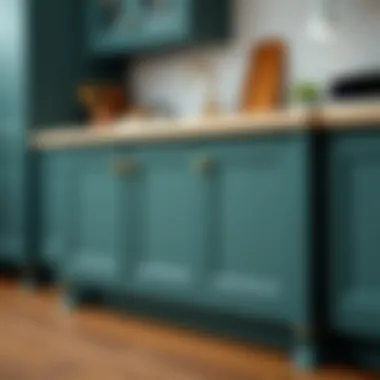
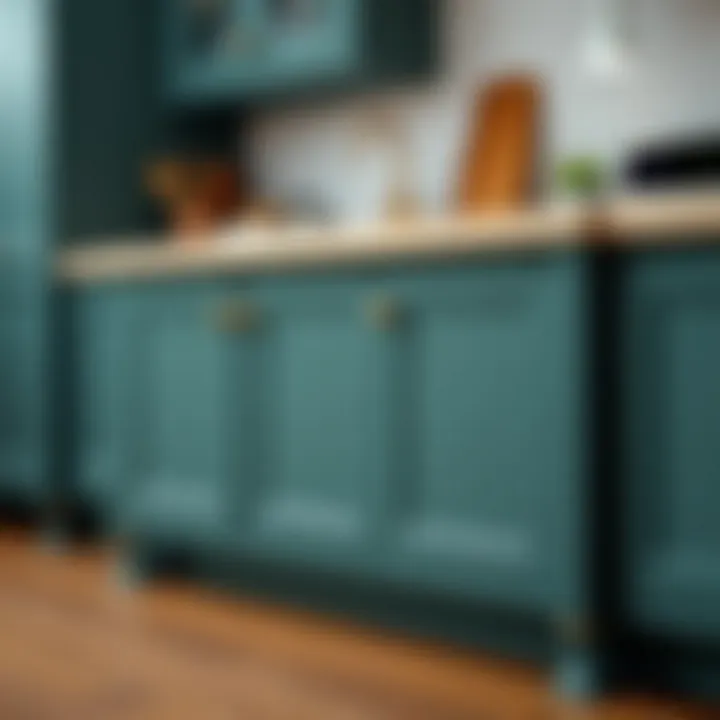
The primary role of decorative feet is to support and stabilize kitchen cabinets. When designed and installed correctly, they ensure even weight distribution, allowing cabinets to maintain their structural integrity over time. Imagine a cabinet loaded with dishes or appliances; if the feet are poorly designed or improperly installed, the cabinet could lean or sag. This could create not just aesthetic issues, but also potential safety hazards.
Strong, well-constructed decorative feet can also prevent issues related to shifting or movement. For instance, a cabinet with sturdy wood legs might withstand the rigors of daily use better than one resting on a basic base. This consideration is paramount, particularly in high-traffic areas like the kitchen where the risk of damage is greater.
Influencing Cabinet Height
Another element to consider is how decorative feet influence cabinet height. They can raise cabinets off the floor, which not only alters the overall look but also impacts functionality. Cabinets elevated by feet can make it easier to clean underneath, providing a tidy appearance. Additionally, they can create a more comfortable reach for the upper shelves, especially for those who might find lower cabinets cumbersome to access.
The choice of foot height can also cater to the needs of different users. For example, a family with young children might prefer lower cabinets, while a household with taller adults could benefit from more substantial feet that raise the cabinet height. This flexibility supports a more customized kitchen environment suited to various lifestyles.
Enhancing Cleanliness
Ease of Cleaning
Ease of cleaning is a crucial aspect of any kitchen design, and decorative feet play a significant role. When cabinets are raised slightly off the ground by decorative feet, it creates a vacant space below. This area can often trap dust and debris, but it also becomes much simpler to clean compared to cabinets that sit flush against the floor. Simple sweeping or mopping can ensure the kitchen remains hygienic and neat without much fuss.
Choosing decorative feet that are easy to maintain, such as those made from metals or polished woods, also maximizes the benefits of this feature, as they often resist staining and can be wiped clean with minimal effort.
Preventing Damage to Flooring
Preventing damage to flooring is another paramount consideration when selecting decorative feet. Poorly designed or inappropriate feet can scratch or dent the flooring beneath the cabinets. By choosing decorative feet with a wider or padded base, homeowners can distribute the weight more evenly and reduce the risk of creating marks or impressions in hardwood or tile flooring.
Moreover, decorative feet can raise the cabinet above high-traffic floor areas. This added clearance helps avoid moisture build-up that could warp or damage flooring materials over time. In essence, smartly chosen feet act as a protective barrier, enhancing both cabinet and flooring longevity.
In summary, while decorative feet might be seen as mere accents, their functional aspects contribute significantly to the cabinet's overall utility and aesthetic appeal.
By considering support and stability, the influence on cabinet height, and their role in maintaining cleanliness, one can make a wiser selection when incorporating decorative feet into kitchen cabinet design.
Design Trends in Decorative Feet
As kitchen designs evolve, decorative feet have taken on a role that extends far beyond mere functionality. These stylish accents play a vital part in shaping the overall aesthetic of kitchen cabinets. When one considers the array of styles available, the importance of selecting decorative feet that align with current design trends becomes paramount. Structuring an inviting kitchen space involves thinking about harmony—how the feet complement the cabinets, the countertop, and even the flooring.
By embracing modern design trends in decorative feet, homeowners can genuinely elevate their kitchen's charm. For instance, minimalistic approaches are on the rise, shifting from heavy, bulky legs to sleeker designs that promote an airy, open feel. This trend not only modernizes the kitchen but also fosters a clean space that resonates with simplicity.
"The feet of your cabinets can be the unsung heroes of your kitchen's overall design. They tie everything together and can elevate the decor aesthetic significantly."
Vintage Revival
Vintage design never seems to fade away. Rather, it morphs and adapts, infusing modern kitchens with a touch of nostalgia. The recent resurgence of vintage-inspired decorative feet taps into a longing for craftsmanship from eras gone by. When selecting decorative feet in this vein, home design enthusiasts often prioritize turned legs or intricately carved feet that echo historical styles. These elements not only impart character but also serve as focal points in the kitchen.
Moreover, incorporating these vintage elements provides a powerful contrast to sleek, modern cabinets. For example, pairing a set of ornate, turned wooden feet with a minimalist shaker-style cabinet can highlight the tension between tradition and contemporary flair, creating a unique and inviting atmosphere.
Sustainability in Materials
In today's design landscape, sustainability is no longer a buzzword; it is a necessity. Homeowners are increasingly mindful of the materials employed in their kitchens, with many looking for decorative feet made from sustainable resources. Eco-friendly options such as reclaimed wood or metal accents contribute to a greener footprint while also presenting a sophisticated look.
Moreover, opting for sustainable materials often leads to unique, one-of-a-kind pieces. Each reclaimed wood foot carries the story of its previous life, lending a sense of individuality to the kitchen. This focus on sustainability not only benefits the environment but also aligns with consumers' growing appreciation for authenticity in design. The promise of durable yet environmentally-conscious products resonates with discerning homeowners and designers alike, enhancing their kitchens without compromising their values.
In summation, the trends shaping decorative feet for kitchen cabinets are rich in history, style, and ethical consideration. The choices available are not merely about function; they are about expressing personal style and values that can transform the mundane into extraordinary. By keeping an eye on these evolving trends, one can ensure that the kitchen remains not only a place for cooking but also a space that reflects individuality and thoughtfulness.
Installing Decorative Feet
When it comes to enhancing the overall aesthetic appeal and functionality of your kitchen, installing decorative feet can make a significant difference. These artistic elements not only lend visual interest to cabinetry but also play a pivotal role in providing structural support. Having a solid understanding of the installation process ensures that homeowners and DIY enthusiasts can execute the task effectively, resulting in a polished, professional finish.
Preparation and Tools Required
Before you dive into the actual installation, preparation is key. Ensuring you have all the necessary tools and materials will save you time and headaches. Here’s a basic run-down of what you will need:
- Measuring Tape: Accurate measurements are critical to ensure uniformity.
- Level: This is crucial for making sure that the feet are installed evenly, especially on uneven flooring.
- Drill: Essential for creating holes for screws, ensuring a secure fit.
- Screws and Hardware: Depending on the weight and the material of the decorative feet, select the appropriate screws that provide adequate support.
- Wood Glue: For added stability, applying wood glue can further secure the decorative feet in place.
- Sandpaper: This may be necessary to smooth out any rough edges on your decorative feet prior to installation.
- Paint or Stain (optional): If your feet need finishing, consider doing this ahead of time for a seamless installation.
Step-by-Step Installation Process
Now that you have everything at your fingertips, let's get into the step-by-step installation process. Each step should be carried out thoughtfully to ensure long-lasting results:
- Measure and Mark: Start by precisely measuring where the decorative feet will go on the bottom of your cabinets. Mark each spot with a pencil for clarity.
- Prepare the Feet: Before fixing the feet, ensure they are clean and dry. If applying any paint or stain, let it dry completely.
- Drill Holes: Carefully drill holes into the marked spots on the cabinetry. Use the level to ensure that each hole is done straight.
- Attach Feet: Line up the decorative feet with the drilled holes and secure them using screws. If necessary, apply wood glue before securing for extra strength.
- Check for Level: After installation, use your level again to confirm that each foot is even and stable, making adjustments if needed.
- Finalize and Clean: Once installed, clean up any excess glue or dust. This step will make your cabinets shine.
Following these steps meticulously not only enhances the cabinet's aesthetics but ensures stability and prevents any potential damage down the line.
Tips for Ensuring Stability
To ensure the longevity of your decorative feet and the overall cabinet, consider these tips:
- Choose the Right Material: Ensure the material of the feet is suitable for the weight of your cabinets. Heavier styles might need sturdier bases.
- Reinforce with Corner Braces: For larger cabinets or heavier decorative feet, consider using corner braces for additional support.
- Periodic Checks: Every now and then, give your cabinet feet a quick once-over to detect any wobbling or signs of wear, adjusting as necessary.
"A little preparation goes a long way; it pays to measure twice and cut once."
Keeping these guidelines in mind will pave the way for a successful installation process. Proper planning and execution here can elevate your kitchen's design while also ensuring the functionality of the cabinetry.
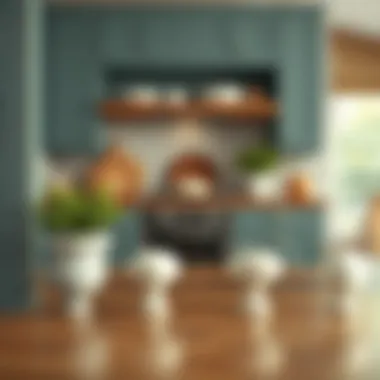
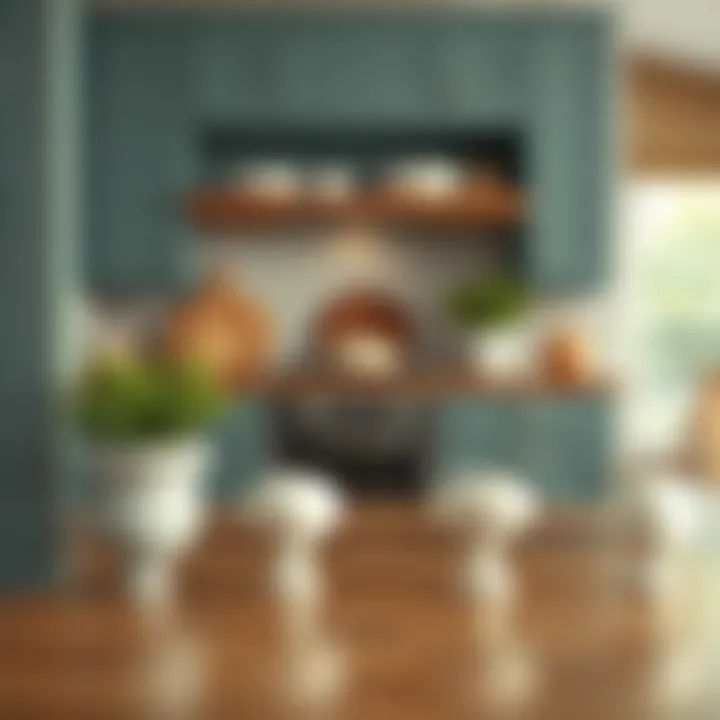
Maintenance of Decorative Feet
To ensure the longevity and appeal of decorative feet, regular maintenance is key. Kitchen cabinets with decorative feet are not only designed for aesthetic value but also serve a practical purpose, including support for the cabinet structure. Therefore, keeping them in good condition is essential for both functionality and the overall look of your kitchen.
Regular monitoring can help identify potential issues early, maintaining the integrity and elegance of the kitchen’s design. Additionally, proper maintenance can prevent costly repairs or replacements further down the line.
Regular Cleaning Tips
Keeping decorative feet clean is a straightforward yet crucial task. Dust and debris can accumulate over time, potentially causing scratches or dullness on the surface. Here are some handy tips for maintaining cleanliness:
- Frequency: Aim to clean the feet at least once a month. If the kitchen is a busy hub, consider adding it to your weekly cleaning routine.
- Gentle Cleaning Agents: Use mild soap solutions or furniture polish designed for the specific material of your feet. For example, wood feet might fare better with specialized wood cleaners, while metal feet require products that don't cause tarnish.
- Soft Cloths: Always use soft, lint-free cloths to avoid scratch damage. Avoid abrasive sponges or rough materials that can mar the finish.
- Inspect: During cleaning, take a moment to inspect for any signs of wear, such as cracks or peeling finishes. Early detection can save a lot of headaches later on.
Preventive Measures Against Damage
Prevention is always better than cure, especially when it comes to decorative feet that can endure wear and tear from daily use. Consider the following preventive measures to keep them looking pristine:
- Avoid Water Damage: Water is a major enemy of decorative feet. Ensure that surfaces are not exposed to excessive moisture. After spills, quickly wipe down the area to avoid potential damage, especially for wood feet.
- Furniture Pads: If your cabinets are near high-traffic areas, consider using furniture pads under them to help absorb shock and prevent scrapes.
- Protective Finishes: Applying a protective layer, like a sealant for wood or polish for metal, can act as a barrier against scratches and stains. Regularly reapply these products to maintain their effectiveness.
- Climate Control: Extreme temperatures can lead to warping or cracking. Ideally, keep your kitchen’s climate stable. Use dehumidifiers or air conditioners to avoid excessive moisture.
- "Maintenance is not just about cleaning; it’s also about protecting your investment in quality design." *
By taking these steps, not only do you enhance the aesthetics of your kitchen, but you also ensure that your decorative feet withstand the test of time.
Selecting the Right Decorative Feet
Choosing the right decorative feet for your kitchen cabinets is not merely an aesthetic choice; it serves to enhance the overall functionality and character of your space. The decorative feet can transform standard cabinetry into a design statement, contributing both style and structure. Proper selection can elevate a kitchen's ambiance, making it feel more inviting while maintaining practicality. Homeowners often overlook this important detail, yet the right feet can tie together various elements within the kitchen, creating harmony in design.
Evaluating Design Compatibility
When you start searching for decorative feet, the first essential step is to evaluate how well they will fit with your current kitchen decor. The styles of your cabinets, countertops, and even fixtures all play a significant role in this decision. If your kitchen features a rustic theme with farmhouse cabinetry, opting for carved wooden feet can enhance that vibe beautifully. Conversely, a sleek modern kitchen may call for minimalist metal accents to resonate with its contemporary feel.
To make the assessment process smoother, consider creating a mood board to visualize how different styles interact with one another. Collect samples of colors, textures, and finishes that are present in your kitchen. This should include cabinet colors, wall paint, and flooring as well. Keep in mind:
- Color Harmony: Make sure the color of the feet complements or contrasts in a visually appealing way with the cabinetry and surroundings.
- Style Consistency: Ensure that your selected decorative feet align with the overarching theme; you’d likely want to avoid mixing ornate, classical styles with ultra-simple modern aesthetics.
- Size and Scale: Remember, the proportion of the feet in relation to the cabinets is key. Opt for feet that don’t overpower your cabinetry; they should enhance rather than distract.
Considering Personal Style and Preferences
Personal style is a crucial piece of the puzzle when choosing decorative feet. This is where you can let your personality shine through. Reflect, what draws your eye? Are you captivated by elegant, intricate designs, or do you lean towards clean lines and contemporary feel? Knowing your own preferences will help guide your selection, ensuring the final choice resonates with you and your lifestyle.
Think about how you use your kitchen as well. If your home is a hub for family and friends, robust and functional feet that are easy to clean might take precedence. On the other hand, if your kitchen is more of a showpiece, you might prioritize intricate designs that contribute to the ambiance. Here are some questions to ask yourself:
- What vibe do I want to convey? If you desire a cozy atmosphere, warm wood tones might fit the bill.
- How much maintenance am I willing to commit to? Some materials require more upkeep than others; choose what aligns with your routine.
- Are there any trends I’m drawn to? While personal style is key, trend awareness can help you stay current without sacrificing your individuality. Remember, your choices do not need to align with fleeting trends; you can embrace classics that have proven timeless.
Ultimately, selecting decorative feet should be an enjoyable process that brings you closer to realizing your ideal kitchen. By focusing on design compatibility and personal style, you ensure that your chosen feet are not only practical but also a reflection of you.
Budgeting for Decorative Feet
When it comes to home renovation, particularly in the kitchen, budgeting plays a critical role. Choosing decorative feet for kitchen cabinets is no exception. These elements go beyond mere aesthetics; they can affect both the appeal and function of the cabinetry. A well-thought-out budget helps ensure you can achieve your desired look without breaking the bank.
Cost Variability by Material and Style
The costs associated with decorative feet can differ significantly based on the material and design chosen. Here’s a closer look at some factors that impact pricing:
- Material Choices: Solid wood typically commands a higher price due to its durability and timeless appeal. For example, oak and cherry may be more expensive than plywood or MDF due to their density and quality. On the other hand, metal options, like aluminum or stainless steel, can offer a contemporary flair at various price points depending on the finish.
- Design Complexity: Simple designs like square posts might be more budget-friendly than intricate, carved legs. Think about the craftsmanship involved—custom designs often come with a larger price tag, while mass-produced items can save some dollars.
- Brand Influence: Recognized manufacturers can charge a premium, but sometimes you get what you pay for in terms of quality and craftsmanship. Consider personal preferences here; a higher price might be justified if it perfectly complements your kitchen aesthetic.
These elements illustrate that decorative feet can range widely in cost, hence it is vital to pinpoint the specific style and material that resonates with both your design vision and your budget limitations.
Finding Cost-Effective Options
Steering through the financial aspect of selecting decorative feet doesn’t mean compromising on style. Here are some practical tips to find cost-effective solutions:
- Shop Around: Don’t settle on the first option you come across. Visiting different home improvement stores, or browsing online marketplaces can unearth hidden gems at varying price points. Websites like Reddit often have updates on sales or discounts.
- Consider DIY: If you're feeling a bit crafty, DIY projects can save a chunk of change. For instance, turning plain blocks of wood into stylish legs can be straightforward if you have some basic tools. There are numerous tutorials available; platforms such as YouTube or specialized blogs provide step-by-step guidance.
- Check Local Classifieds: Sometimes, locals sell bespoke furniture or décor at competitive prices. Websites like Facebook Marketplace or Craigslist can have intriguing steals, especially for those looking to upcycle or repurpose.
"A penny saved is a penny earned." This adage holds true in kitchen renovations. Keeping an eye out for deals can significantly lower your expenses.
- Explore Seasonal Sales: Annual sales events often provide discounts on home improvement items. Black Friday, Labor Day, or Memorial Day sales could lead to fantastic deals on decorative feet.
By adopting a proactive approach, homeowners can ensure their kitchen’s aesthetics come together harmoniously while staying within a sensible budget.
Culmination
In wrapping up this exploration of decorative feet for kitchen cabinets, it's clear that these seemingly minor elements can have a significant impact on both the aesthetics and functionality of your kitchen space.
Summary of Key Points
Throughout this guide, various essential considerations were examined, all leading back to the notion that decorative feet are more than just a pretty face. They serve crucial roles in enhancing the overall design of cabinets, providing stability, and even impacting ease of cleaning.
- The importance of selecting the right style, whether traditional, modern, or custom, aligns your cabinets with your unique vision.
- Materials were highlighted, stressing that the choice between wood, metal, or composites can affect both the durability and appearance.
- We looked into practical aspects such as installation and maintenance, which are often overlooked but vital to ensuring long-term satisfaction with your kitchen cabinetry.
Final Thoughts on Decorative Feet
Decorative feet for kitchen cabinets might not be the first thing that comes to mind when planning a kitchen remodel, yet they do pack a punch in the design department. When chosen wisely, they can echo the overall theme of a kitchen, from rustic farmhouse vibes to sleek, minimalist styles.
Investing time in selecting the appropriate decorative feet can transform your cabinets from bland to beautiful. Consider them as the punctuation in the story of your kitchen; without them, the narrative may fall flat. The bottom line is that a well-chosen piece can echo style and provide subtle support, while contributing to practicality. In the end, it's about finding that sweet spot where design meets functionality.
"Details matter. It's worth waiting to get it right." - Unknown
Remember, when kitchen aesthetics meet functional needs, everyone wins. So go ahead, let those feet shine as a vital element in your kitchen design!





